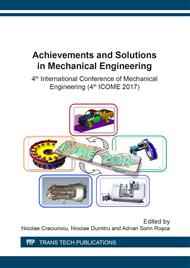[1]
Valery Marinov, Manufacturing Technology, Chapter: Cutting Temperature, pp.74-76.
Google Scholar
[2]
Francis C. Moon and Tamas Kalmar-Nagy, Nonlinear models for complex dynamics in cutting materials, Phil. Trans. R. Soc. Lond. A (2001) 359, pp.695-711.
Google Scholar
[3]
Wiercigroch, M., Krivtsov, A., Frictional chatter in orthogonal metal cutting, Phil. Trans. R. Soc. Lond. A (2001) 359, p.713 – 738.
DOI: 10.1098/rsta.2000.0752
Google Scholar
[4]
Grzegorz Litak, Arkadiusz Syta, Marian Wiercigroch, Identification of chaos in a cutting process by the 0–1 test, Chaos, Solitons and Fractals 40 (2009) 2095–2101.
DOI: 10.1016/j.chaos.2007.09.093
Google Scholar
[5]
M.T. Rosenstein, J.J. Collins, and C.J. De Luca, A practical method for calculating largest Lyapunov exponents from small data sets, Physica D, 65, 117-134. (1993).
DOI: 10.1016/0167-2789(93)90009-p
Google Scholar
[6]
Grzegorz LITAK, Rafał Rusinek and Andrzej Teter, Nonlinear Analysis of Experimental Time Series of a Straight Turning Process, Meccanica 39: p.105–112, (2004).
DOI: 10.1023/b:mecc.0000005140.26808.28
Google Scholar
[7]
Bartosz Powałka, Mirosław Pajor, Stefan Berczyński, Identification of nonlinear cutting process model in turning, Advances in manufacturing science and technology, Vol. 33, No. 3, 2009, pp.17-25.
Google Scholar
[8]
Mohammad. S. Hajmohammadi, Mohammad R. Movahhedy, Investigation of thermal effects on machining chatter using FEM simulation of chip formation, Procedia CIRP 1 ( 2012 ) p.50 – 55.
DOI: 10.1016/j.procir.2012.04.007
Google Scholar
[9]
Tamas Insperger, Gabor Stepan, Janos Turi, State-dependent delay in regenerative turning processes, Nonlinear Dyn (2007) 47, p.275–283.
DOI: 10.1007/s11071-006-9068-2
Google Scholar
[10]
X. -H. Long, B. Balachandran, B. P. Mann, Dynamics of milling processes with variable time delays, Nonlinear Dyn (2007) 47, p.49–63.
DOI: 10.1007/s11071-006-9058-4
Google Scholar
[11]
Abdelkader Karas, Mohamed Bouzit, Development of a thermal model in the metal cutting process for prediction of temperature distributions at the tool-chip-workpiece interface, Journal of theoretical and applied mechanics, 51, 3, pp.553-567, Warsaw (2013).
Google Scholar


